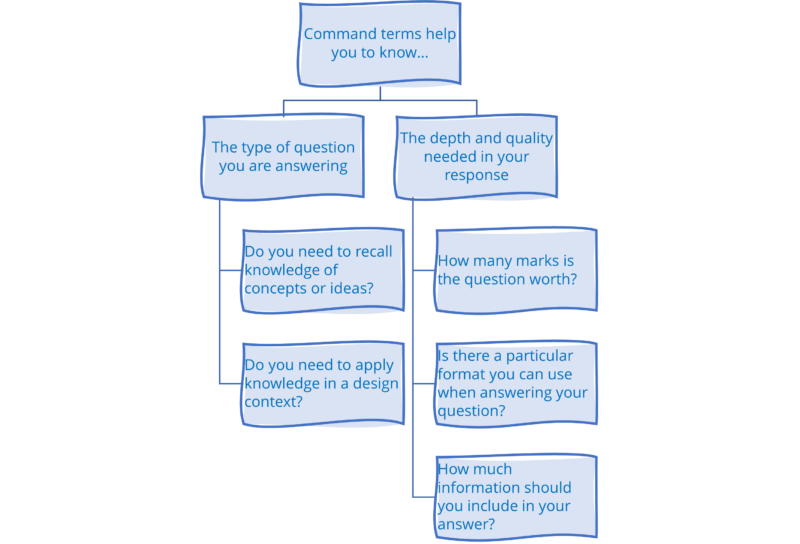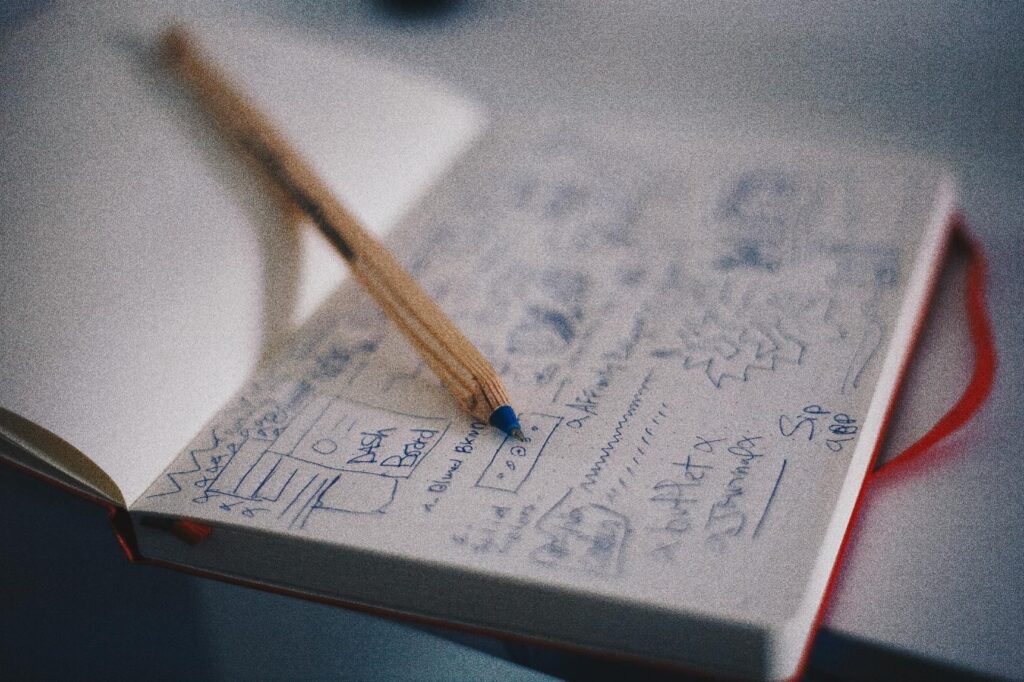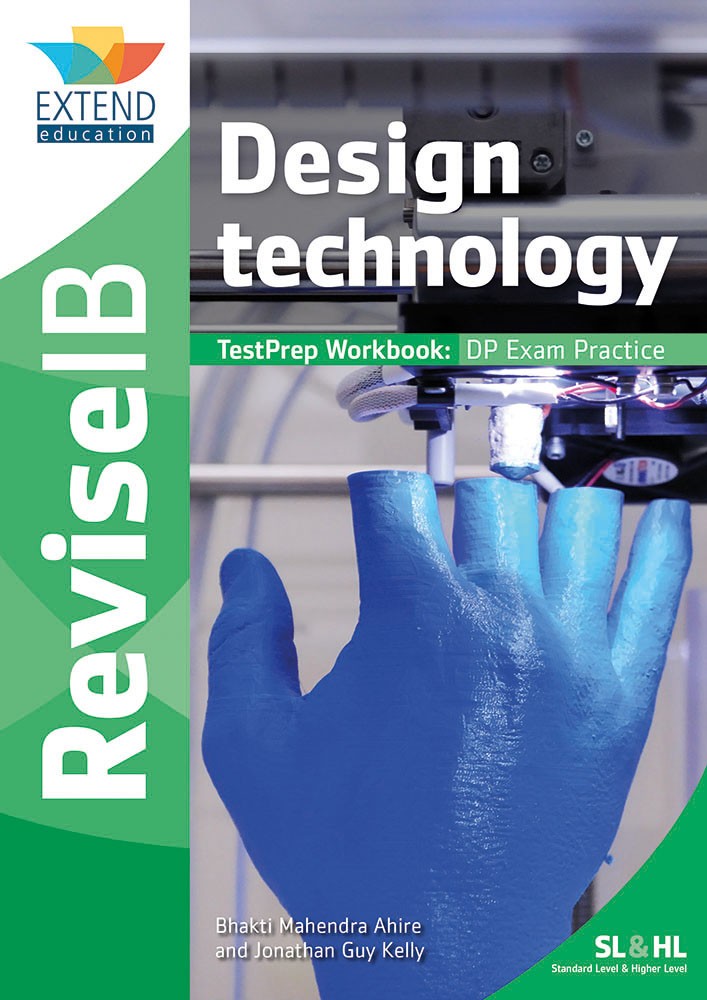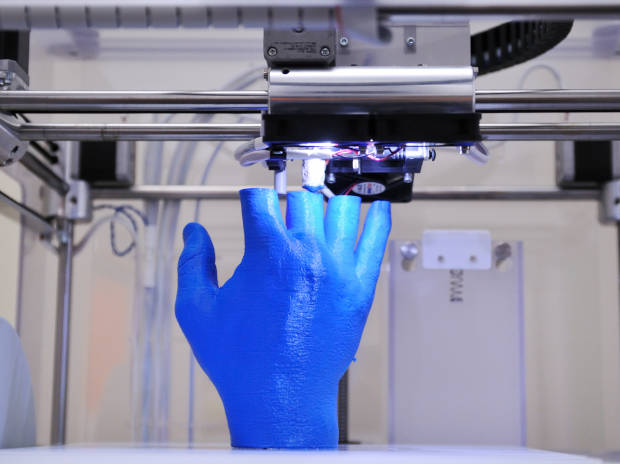Bhakti Ahire is a lead author and an experienced Head of Design Technology with a demonstrated history of working in IB Education. Her book, Design Technology (SL & HL) TestPrep Workbook is available in the Revise IB series.
1. Read the question carefully and pay attention to the command terms.
First, make sure you clearly understand the data, descriptions, and details in the question.
Second, examine the command terms being used in your questions. This is really important!

2. Connect EVERYTHING to sustainability.
If you revise everything in the syllabus, you usually end up with one main concept: the challenge of sustainable design. This is because it is the most desirable outcome for designers today.
So, make sure you understand:
- environmentally-friendly design
- biodegradability
- cradle-to-grave/cradle-to-cradle analyses
- sustainability
- waste management
- energy production.
Make sure you have a general understanding of how these things all fit together so that you can loosely discuss the impact that design has on these areas. Be aware of how designers can exert control over these factors and what the consequences are.

3. Determine the DT topic before you answer questions in Paper 2 and Paper 3.
What DT topic does the question refer to? Is it from the standard level (SL) or higher level (HL)? Remember that a case study for Paper 2 and Paper 3 may require you to use your knowledge of several related topics.
4. Learn terminology and definitions.
In DT, you only need a few, but you should spend some time defining key terms and ideas. They’re not only useful when asked directly what something means, but you can incorporate them into your answers to demonstrate your knowledge.
5. Demonstrate your knowledge of science and mathematics.
You must be able to demonstrate mathematical and scientific knowledge as well as an understanding of design technology in general.
6. Put yourself in the shoes of the user and designer.
Consider how a user might interact with a product. What are their requirements, challenges, and needs? Make connections between the material covered in class and how a designer might apply that material in the context of a design.

7. Sort your response into paragraphs and do not repeat points.
When answering questions with command terms like Explain, Describe, Analyze, or Outline, group your responses into clusters. A cluster is simply like a paragraph. Each cluster should have a single idea that is supported by specifics and examples.
8. Prepare your response.
Pay attention to the marks and the command terms. Use this information to plan your response to the question. For example:
- How many points you will list.
- How much detail is needed.
- How you should organize your response.
9. Avoid terms that are generic.
Remember not to answer in broad terms like ‘wood’ or ‘plastic’. Try to be as specific as possible, such as ‘oak’ or ‘high impact polystyrene’.
10. Remember that exemplification is everything.
Provide examples to demonstrate a point whenever possible. This can demonstrate your depth of understanding and the additional information required to move you up to a higher mark band. Get some really good examples of design concepts memorized. These are usually pretty easy to come by and can often be made up on the spot, but know some to get some detail on them so you can show the marker you know what you’re talking about.
11. Take your time on multiple choice questions.
Don’t skip over the multiple-choice questions because you think they’re simple. There will be some difficult questions that will require thought and focus. Make sure to read them thoroughly. If you aren’t sure on multiple-choice questions, eliminate the answers that you know are incorrect and select your answer from the ones that remain.
12. Think and plan for questions with extended responses.
Devoting time to thinking about and planning answers to extended response questions is essential.
Don’t spend time writing an introduction in your answer. It is far more important to get as much information down as possible and you may not have much time.
You may be asked for your opinion on issues at times. Use clear evidence to back up your point of view. Consider what information might help you demonstrate to the examiner why you made your decision. It’s critical to confidently explain why you’ve reached that particular conclusion.
If you’re not sure what the question is asking, cross out the words you don’t understand and see what’s left. Can you identify keywords or concepts about which you can write. Make an effort not to repeat yourself. This is a waste of time because you cannot get double credit for the same thing.
13. Read widely daily.
Because the IB DP is a globally-focused curriculum, having current knowledge of world events is critical to success in nearly all subjects: languages, humanities, sciences, and so on. Setting aside some time each day to read the news, even if it’s just 10 minutes on the way to school, is a good way to start.

14. Regularly revise content.
Do not wait until mocks or mid-semesters to begin revising, instead, spend 10 minutes each day summarizing what you learned in your design class.
15. Understand your mark schemes.
To ace your exams, you must first understand what the examiners are looking for. It’s as simple as becoming acquainted with mark schemes and rubrics.
From my experience as an examiner, examiners will strictly follow the mark scheme. They will neither award marks for points that are not in the mark scheme nor for repeating what is already in question. For essay questions, examiners will not mark across clusters or award marks for repetition or for points from the same marking point in the mark scheme.
16. Making Use of IB DP Past Papers.
If you’ve seen TED Talks on effective study habits or study-focused YouTube videos (‘How I Got A 40+! in IB’), then you are already aware of the benefits of using past papers. Past papers are essential for familiarising yourself with the examination format and providing a somewhat accurate simulation of the actual IB exam, as any former IB student will tell you.
17. Decide when you should use past papers.
In my experience, I recommend starting these in the second year of the diploma programme, preferably once you finish your design technology IAs or have covered the necessary syllabus content until then. Past papers may introduce topics that you had previously treated separately and also introduce unseen data to which you are expected to apply practical knowledge or skills.
18. Make use of all available resources.
I would strongly recommend the use of some online websites written by experienced DT teachers such as:
These are great for learning the SL and HL syllabus content together with the textbook and your teacher’s notes.
Also, don’t forget to use your IB resources such as the design technology guide, subject reports, and past papers!
Utilize all of the products you’ve examined, designers you’ve looked at, design processes you’ve used, and so on.
Don’t just rely on the information provided in class. With over 1.5 million graduates worldwide, online learning resources are abundant and, in most cases, free.
Here are a few of my personal recommendations to give yourself a new perspective on design:
- Design magazines such as Yanko Design: https://www.yankodesign.com/
- Core 77: https://www.core77.com/
- Curve: https://www.curvelive.com/
- Dezeen: https://www.dezeen.com/design/products/
- Wired: https://www.wired.com/tag/industrial-design/
Best of luck!

Bhakti Ahire is the lead author of Design Technology (SL & HL) TestPrep Workbook – the five star exam practice book published by Extend Education.
With three full sets of exam-style practice papers for SL and HL students, this bestselling Revise IB book gives all the information students need for their IB Diploma Programme design technology SL and HL exams.
$18.99 / £16.99 / €19.99


